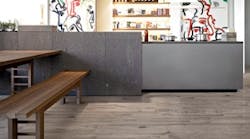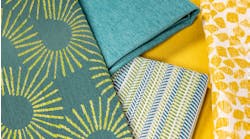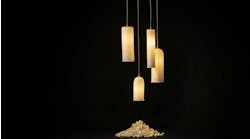The next time you walk across a wooden floor in a museum or a restaurant, you may want to take a closer look. There’s a distinct chance that you aren’t walking on wood at all, but on tile designed to mimic wood.
Thanks to advancements in digital printing and design, tile is no longer relegated to a supporting role in kitchens and bathrooms. New tile designs have become increasingly adept at mimicking other materials, allowing them to fit into a wider range of aesthetic designs and environmental requirements.
“Ceramic and porcelain tiles are taking on the look of various kinds of woods and wood cuts, stone (marble, alabaster, travertine, etc.), minerals like agate, concrete, formwork cement, resin, etc.,” explains Kristin Coleman, a marketing rep for Ceramics of Italy.
tile revitalized
The technology behind tile design and production is responsible for the sector’s new and refreshed aesthetic. Previous attempts to create tiles that mimicked other materials
were poorly designed and produced, yielding unrefined and unnatural-looking patterns.
“What began as copies with awkward repeats of otherwise randomly occurring veining and visibly apparent silk screen markings has evolved into randomized products utilizing the latest in inkjet technology, where photographs of actual source material such as natural stone are used as a digital feed for the inkjet process. The resultant product may have a repeat of one piece every 200-plus square feet, yielding an attractive, natural-looking finished installation,” says Joshua Levinson, president of Artistic Tile. “When placing a porcelain reproduction side-by-side with the natural stone it drew its inspiration from, it can be difficult to determine which is the natural product.”
Thanks to this technology, the tiles are different, offer infinite variations of pattern, and boast the superior aesthetic quality that is representative of natural and handcrafted materials.
“With the introduction of 3-D digital print technology, almost any surface can be scanned and replicated on tile,” says Judy Mevius, marketing communications manager for American Marazzi Tile. “The possibilities are nearly endless—the same rich color variations, the dramatic veining, the sensuous movement found in natural products are available in porcelain.”
advantageous attributes
Tile’s flexible appearance allows it to stand in for other materials, even allowing it to be used in scenarios where the use of the mimicked material would not be an option.
“In commercial applications, these tiles have opened up the door to greater creativity in heavy-duty commercial applications,” says Linda Kay Mracek, principal designer with Aviar Design. “The look of wood and being able to utilize that look in a high-traffic area or where codes require sealed flooring, or being able to have the look of an expensive stone floor in a public space where costs and maintenance are a concern gives the designer a lot more choices, and still meets the requirements of durability in a space.”
The high-quality appearance of tile offers new opportunities for the material, but it’s the inherent technical characteristics that really make it shine. The advantages, according to Coleman, are:
- Tile is resistant to extreme weather conditions, chemical, impact, water, moisture, temperature change and UV rays, giving ceramics the edge in hard environmental stress situations.
- Tile is fire-resistant and does not create additional combustion materials—in fact, it may help reduce the spread of fire. It does not contribute to the toxic fumes and smoke when a fire occurs.
- Ceramic and porcelain tiles are easy to maintain—often warm water and natural cleaners are the only products required—which contributes to cost savings over the life of the installation.
- Tile is durable and long-lasting. Natural hardwood has an expected life-cycle of 15 years, while ceramic and mosaic tile has a life-cycle of roughly 50 years, according to a Tile Council of North America study of floor covering costs from 2006.
- Ceramic tile is a hygienic product that is suitable for sterile environments. Some tiles are even made with special antibacterial properties.
- They can be used in wet environments like bathrooms, spas and pool areas where wood and stone can’t.
- Ceramic tile has minimal damage costs because it can be spot-repaired.
In addition to the characteristics that tile possesses, sometimes it’s the lack of influencing characteristics that make it especially appealing to designers.
“We recently specified a tile that looked like a travertine stone product,” Mracek says. “Because the tile will not have the natural ‘air pockets’ that can open up and create a hole and dirt trap that real travertine has, the maintenance is much better with the tile.”
trending tiles
Just like other materials, the look of tile ebbs and flows with popular trends. But because manufacturing and printing technology has enabled ceramic tile to mimic so many other materials,
the possibilities are much broader. For example, according to Levinson, a new trend on the market is the replication of concrete, including imprints of wooden forms used in the original pour. Other design trends Coleman is starting to see include:
- Graffiti and urban-inspired tiles
- Monochromatic tiles that are sculptured and three-dimensional
- Tiles with a rustic terra cotta or wood look
- Monolithic (20-millimeter thick) porcelain slabs that can be dry-laid
- Self-fixing floors
- An increase in the use of recycled content, from reintegrating manufacturing residues into the final product to using recycled glass from discarded TV screens and computer monitors
- Mixing and matching the look of various materials, such as combining the look of alabaster and marble into one tile or wood and concrete into one collection
Mevius notes that another emerging trend is in thin tiles—those that are less than 5 millimeters thick.
“Slim profiles and a lightweight design make thin tile easy to handle and work with, and, therefore, the ideal solution for renovating residential and commercial areas subject to light traffic,” she says. “It allows for considerable savings in terms of time, consumption and working costs—aspects that are indispensable in situations where it is essential for renovation work to be carried out quickly without interrupting services.”
In addition, thin tiles can assist in meeting sustainability needs and goals. “Thin tile reduces environmental impact throughout all phases of the installation’s life-cycle,” Mevius says. “It requires fewer raw materials and less energy to manufacture, as well as to ship.”
banking on tile
Tile is often chosen for its ability to stand out, but it’s also frequently called upon because of its ability to blend in—in either application, tile can make an impact. When building the First Bank & Trust branch in Skokie, Ill., architectural firm BEHLES + BEHLES used Marazzi’s Ventilated Wall System as a visible element of the project’s eco-conscious design strategies, allowing the bank to make a statement about its environmental
goals while maintaining the conservative, stable appearance often favored by financial institutions.
“Because tile is a natural material—it comes from clay and other products that are of the earth—it has the ability to reflect and look as though it’s a natural product, as opposed to a synthetic appearance,” says Joseph Behles, principal with BEHLES + BEHLES. “The colors, the general warmth, the values of the material, for this project, allowed it to have a lasting and timeless appearance.”
Approximately 5,200 square feet of Marazzi Architectural’s MONOLITH porcelain stoneware series in rectified, large-format 12-inch by 24-inch and 24-inch by 48-inch modules were installed on site-specific aluminum framework. The white and gray porcelain achieves a natural granite/porphyry stone look while boasting 40 percent recycled content.
An extra element of continuity was also added to the project—not only do the tiles on the exterior complement the space’s natural elements, but they also literally flow into the interior of the bank.
“We looked at large-scale tiles and the ability to use them in this kind of rain-screen cladding system. Of the various manufacturers, we chose Marazzi because of the opportunities to use same-size tiles in different colorways and then coordinate those with the interior products we used for floors, walls, and also for large-scale and smaller-scale floor tiles,” Behles says.
“This facility is a bank that has made a huge commitment to be a community and neighborhood bank,” he adds. “We liked the opportunity to use a range of products that have withstood the test of time. We wanted something that looked substantial and long-lasting, and these colors go back to the color in nature; it’s reminiscent to natural stone colors, and the bank liked that and the timeless and solid appearance that it gave the building.”
Kylie Wroblaski is a former editor for BUILDINGS magazine, and has written previously about architecture and facilities management.


